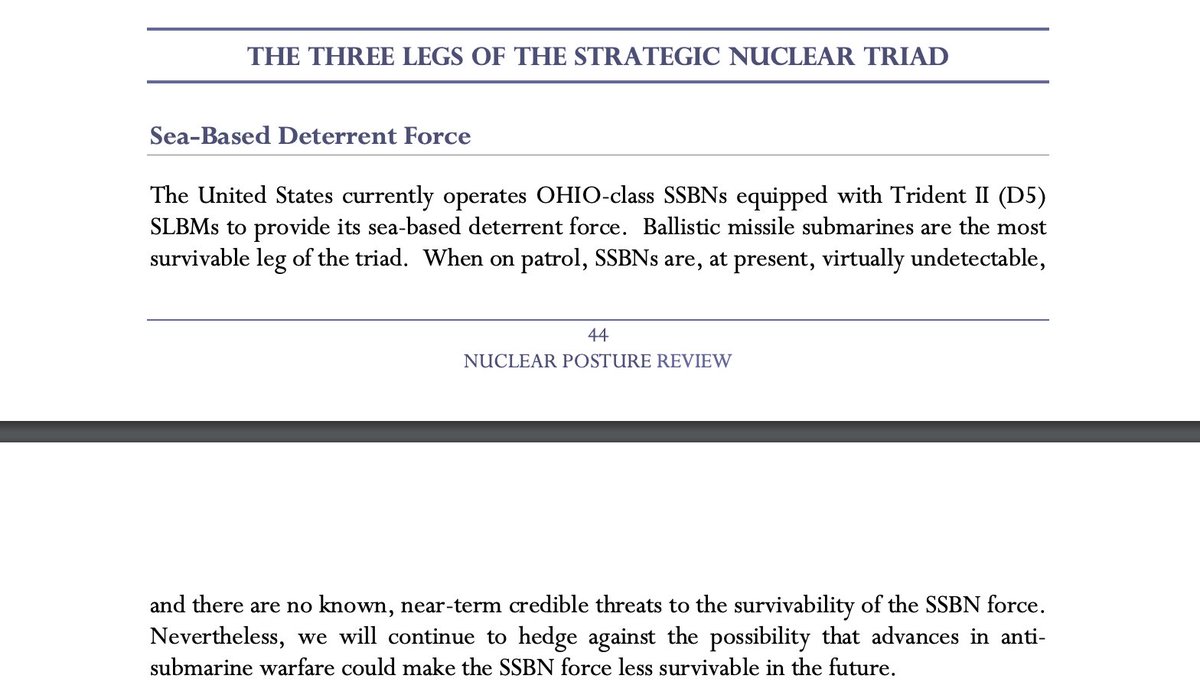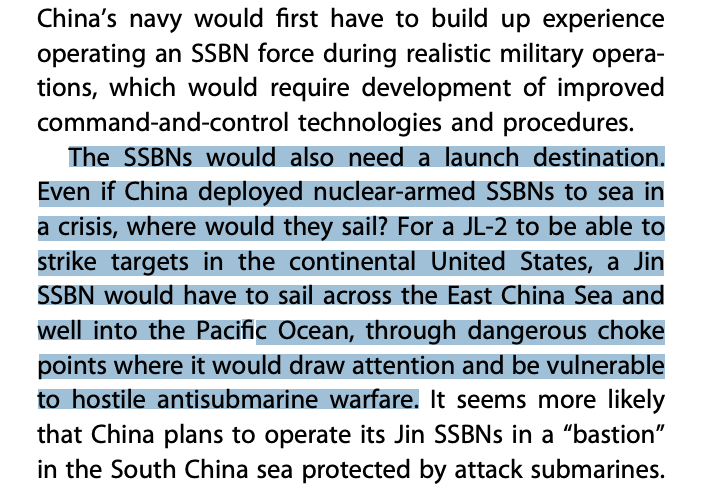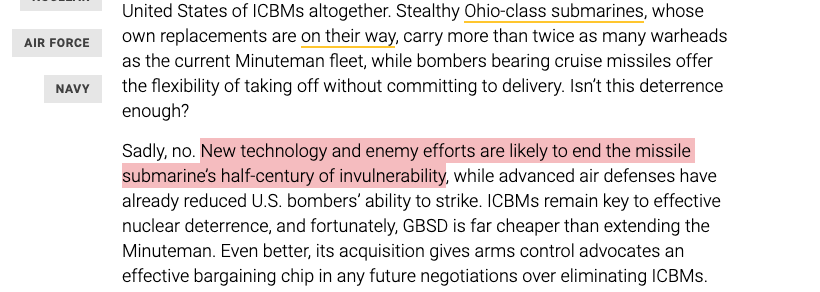There is a ton of hype around the notion that "new technology and enemy efforts" is likely to make American SSBNs suddenly vulnerable, and therefore we need to keep ICBMs around forever just in case.
But this claim doesn't seem to hold water (forgive me).
Short, 1-min thread https://twitter.com/DefenseOne/status/1336286158641389568
https://twitter.com/DefenseOne/status/1336286158641389568
But this claim doesn't seem to hold water (forgive me).
Short, 1-min thread
 https://twitter.com/DefenseOne/status/1336286158641389568
https://twitter.com/DefenseOne/status/1336286158641389568
1. US SSBNs are among the quietest submarines on the planet.
The 2018 Nuclear Posture Review even calls them "virtually undetectable" & "there are no known, near-term credible threats to the survivability of the SSBN force."
The same cannot be said for Russian or Chinese SSBNs.
The 2018 Nuclear Posture Review even calls them "virtually undetectable" & "there are no known, near-term credible threats to the survivability of the SSBN force."
The same cannot be said for Russian or Chinese SSBNs.
2. The next gen of US SSBNs––the Columbia class––is expected to be even *quieter* than the Ohio class.
They will use an electric-drive propulsion train, meaning that a quiet electric motor will be turning the propellor, instead of noisy mechanical gears.
https://www.everycrsreport.com/files/20000731_RL30622_c288e8b1829d574fffb93ddf56d0891b36cff9fc.pdf
They will use an electric-drive propulsion train, meaning that a quiet electric motor will be turning the propellor, instead of noisy mechanical gears.
https://www.everycrsreport.com/files/20000731_RL30622_c288e8b1829d574fffb93ddf56d0891b36cff9fc.pdf
3a. But there appears to be this idea in many op-ed pages that an unforeseen technological breakthrough will occur one day, and suddenly render the US SSBN force vulnerable.
Technology development is slow, however, and doesn't occur in a vacuum.
Technology development is slow, however, and doesn't occur in a vacuum.
3b. The history of submarine-quieting and submarine-detection technologies is intertwined.
During the Cold War, the US Navy had an advantage over the USSR specifically by solving the anti-sub warfare problem against its own submarines.
Why wouldn't this still be the case today?
During the Cold War, the US Navy had an advantage over the USSR specifically by solving the anti-sub warfare problem against its own submarines.
Why wouldn't this still be the case today?
4. Tech development also doesn't benefit everyone equally.
The US development of SOSUS during the Cold War didn't make the oceans "transparent" for everyone––just the US.
USA remains the leader in anti-sub warfare. If tech breakthroughs happen, it'll probably be the US' doing.
The US development of SOSUS during the Cold War didn't make the oceans "transparent" for everyone––just the US.
USA remains the leader in anti-sub warfare. If tech breakthroughs happen, it'll probably be the US' doing.
5. Geography heavily favors the United States, even with “transparent” oceans.
US SSBNs operate relatively uncontested relative to nuclear-armed rivals. Few chokepoints, lots of US allies/territories.
This is NOT the case for other countries, especially Chinese subs.
US SSBNs operate relatively uncontested relative to nuclear-armed rivals. Few chokepoints, lots of US allies/territories.
This is NOT the case for other countries, especially Chinese subs.
6. Even if an adversary *were* able to detect, track, and target a US ballistic missile submarine on patrol, destroying it is another matter entirely.
See Austin Long's great @lawfareblog piece for more details on just how difficult this is. https://www.lawfareblog.com/location-location-location-evaluating-risks-submarines-low-yield-warhead-and-submarine-missile
See Austin Long's great @lawfareblog piece for more details on just how difficult this is. https://www.lawfareblog.com/location-location-location-evaluating-risks-submarines-low-yield-warhead-and-submarine-missile
7. So why do we keep seeing these vague arguments about how "new technology and enemy efforts" will suddenly make US SSBNs vulnerable, when this doesn't seem to be the case?
In reality, this claim is being made in service of an entirely different argument––one about ICBMs.
In reality, this claim is being made in service of an entirely different argument––one about ICBMs.
8. As a 1993 @USGAO report notes, DOD regularly uses "unsubstantiated allegations about likely future breakthroughs in Soviet submarine detection technologies" [...] "as a justification for costly modernizations in the other legs to 'hedge' against SSBN vulnerability."

 Read on Twitter
Read on Twitter





![8. As a 1993 @USGAO report notes, DOD regularly uses "unsubstantiated allegations about likely future breakthroughs in Soviet submarine detection technologies" [...] "as a justification for costly modernizations in the other legs to 'hedge' against SSBN vulnerability." 8. As a 1993 @USGAO report notes, DOD regularly uses "unsubstantiated allegations about likely future breakthroughs in Soviet submarine detection technologies" [...] "as a justification for costly modernizations in the other legs to 'hedge' against SSBN vulnerability."](https://pbs.twimg.com/media/EoutmFHWEAUXD6S.png)


